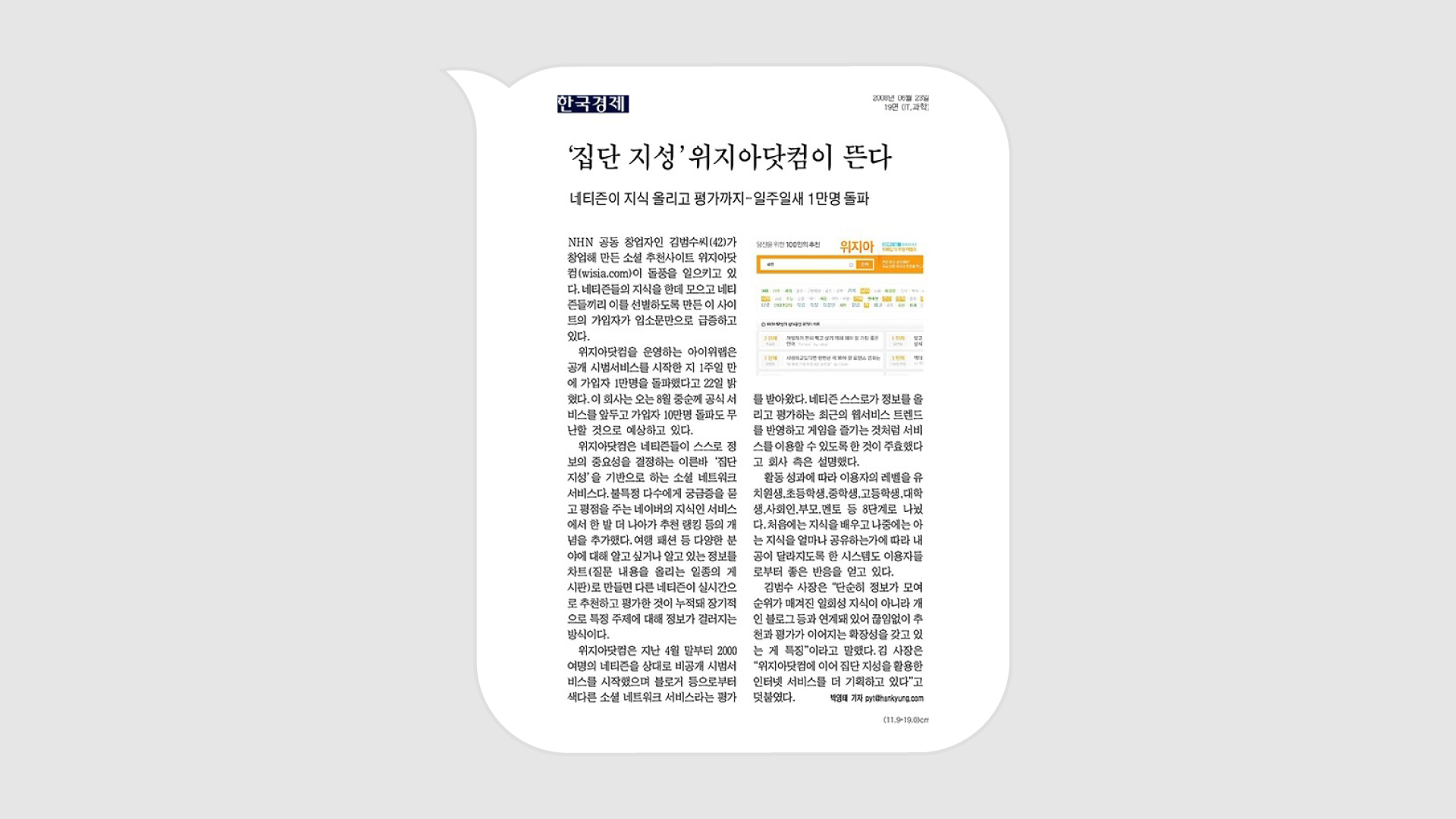All Eyes on KakaoTalk
Kakao's growth process mirrored through journalists’ eyes
Journalists turn their gaze toward KakaoTalk and the IT industry on behalf of readers. Here are two reporters who have always rushed to the scene to take charge of the assignment desk for more than a decade. We wondered how Kakao is viewed from an 'outsider's perspective.'
# Dream
Park Young-Tae, the chief editor of Korea Economic Daily (“Chief Editor Park”), began his story, recalling his first encounter with Brian (Chairman Kim Beom-su).
"I was invited to an NHN year-end party held at Star Tower, Yeoksam-dong. Then CEO Kim Beom-su addressed the audience, ‘We all must have a dream, and roll with it together.’ His words struck a chord even in the heart of outsiders, as I remember. One day, he abruptly left for the USA and returned to Korea after several years. He volunteered for a press interview and said, ‘My heart was racing when I saw the iPhone released. I will grab a new opportunity and resume business.’ His first service, 'wisia,' however, didn't attain any success. Against all odds, KakaoTalk was released. He said KakaoTalk wasn't the core service provided by Kakao. Initially, KakaoTalk, a mere supplementary service product, aimed to support the expansion of other services. He expected KakaoTalk to play a content role. However, positive user responses exploded, and KakaoTalk became a primary service. So, there came one more interview, where I eventually put all the pieces together about the 'dream' he mentioned long ago.” Park added, “He also had the ambitious goal of fostering 100 startup CEOs."

Chief Editor Kim Hyun-Ah of eDaily ("Chief Editor Kim") picked up Park's words where he had left off. She said that a primary concern of IT reporters in 2010 was whether KakaoTalk would begin charging.
"When the number of subscribers exceeded 1 Million, there was a lot of talk among field reporters of KakaoTalk's capability to cope with server expenses and personnel expenses. KakaoTalk made several announcements that 'it would never become a paid service.' Chairman Kim had an entirely different viewpoint. He believed that if the app became an ingrained habit with millions of users, someone would willingly invest, and others would sell their ideas. In those days, no company adopted a strategy entirely focused on users’ needs. Kakao set the standard - what kind of philosophy and dream do we need to become a platform business? In fact, Kakao was at a financial impasse but never yielded to it. The company boldly waded through difficult situations while upholding its horizontal culture and providing what users needed against mighty market competition.”
# Clue from desperation
The year 2010 is considered the first year of the 'fast-spreading smartphone' after iPhone’s 3GS rolled onto the Korean market. KakaoTalk user expansion ran roughly parallel to smartphone penetration. People bought smartphones to use KakaoTalk or installed the app while happening to keep a smartphone in their hands – the virtuous circle. KakaoTalk now wears the crown in the 'app' market. People remember the name KakaoTalk from the days of its inception. However, reporters point out that we should also examine the previous three years.
Park explained, "

IWILAB was desperate not to miss any feedback back then, which naturally led to favorable public opinion. A massive survey on UX/UI users, which is now common, was conducted at the time. It was rare for a startup of mere dozens of employees to run such a large scale survey.
Kim found that KakaoTalk might be able make a clean sweep of the market by proactively shaping public perceptions.
"When KakaoTalk was released, its competitors called themselves 'mobile messengers.' In contrast, KakaoTalk was quickly positioning itself as a 'free messaging service.' SMS messages were charged 30 KRW per segment, and MMS was more expensive then. Whenever one’s friend appeared on the KakaoTalk screen, people thought, 'Oh, he (she) bought a smartphone, too.’ Users could see that they had more friends to chat for free. Naturally, users were grateful for this intuitive service. It was a meaningful outcome earned by the company's service philosophy rather than a marketing strategy.”
# Unconventional player
KakaoTalk persistently adhered to its free-of-charge policy, causing the company to handle many twists and turns. Even its business model appeared as a novel example in the history of Korean corporations. Editor Kim recalled the moments leading up to 2012.
"While observing KakaoTalk user behaviors and deciding to show the unread counts on the chatroom screen, I thought the service might well be successful at a certain level. However, no one ever predicted that the company would earn this much success in various business portfolios. As far as I remember, Kakao encountered a crisis when its competitors jumped into the game platform business in succession after Anipang's sensational popularity. However, as Chairman Kim's friends chipped in, and domestic and foreign IT companies made a strategic investment, Kakao was able to break away from the crisis. Its growth spurt came afterward. Other unconventional approaches? I think sending gifts on KakaoTalk uniquely demonstrated how spending money on others could promote happiness in the market. Furthermore, Kakao has already permeated the financial sector, the ultimate area of credibility.”

Chief Editor, Park Young-Tae, pointed out the association between character IP and business as an exceptional case.
“A scant 10 years ago, the character business was considered manufacturing dolls, toys, and stationery products – probably production of movies or TV shows at the utmost. Everyone predicted that Kakao Friends would grow to that extent, but it surpassed everyone's expectations. Kakao Friends’ viewpoint melded with every level of Kakao services, including KakaoTalk. Users could feel as if they were breathing with characters while using Kakao services. Such familiarity made for unending opportunities to develop new business pipelines.”
# Impression
The two reporters agreed that the impression a company and its top management form significantly contributes to building its reputation. Park recollected that Chairman Kim Beom-su had long empathic interactions with reporters. Hence, reporters waited for Kim and his company’s next service ideas.
"I was impressed with his leadership of the Game Association and taking the initiative to breed relevant industries. Hangame's Go-Stop stirred up controversy about the online game's speculation aspects. Chairman Kim probably had been under unrelenting pressure. Nevertheless, he stepped up. Chairman Kim looked un-authoritative, easygoing, and warm-hearted, definitely unlike a typical entrepreneur. His unconventional approach left a lasting impression on me, which often burst into more news articles, perhaps spontaneously. It was not only me who wrote for him, but most other reporters.”
Chief Editor Kim saw that Kakao's bold hiring and M&A created its agile and decisive impression. “In the early days, Kakao put up, for CEO, Lee Je-Beom who was only in his 20s. It then scouted CEO, Lee Seok-Woo, when the vast scope of user communication was required, chose an investment banker Lim Ji-Hoon as CEO when spin-offs and M&As were necessary, and placed the responsibility of spearheading monetization upon Co-representatives Yeo Min-Soo and Cho Soo-Yong. Putting a round peg in a round hole contributed much to Kakao's image. Good human resource management is essential for all businesses. Taking over 'Kimgisa Navi' to gain leverage for KakaoMobility expansion and decisively acquiring Loen Entertainment to secure a cash cow, these decisions were unconventional.”
# Wistfulness, and a must-do
'Domestic platform.' That is one of the modifiers that describes KakaoTalk. Editor Kim Hyun-Ah realized that KakaoTalk could have branched out into the world, but it didn’t. “It was such a shame,” she added.
"NAVER did not achieve significant long-term results in the Japanese search market. However, they had never been short of capital until they made a go with LINE. They needed a tediously long period until LINE settled into the Japanese market and moved onto the next phase fueled by a blood-partnership with SoftBank. At that time, KakaoTalk gained popularity in the Middle East and Southeast Asia, but the budget was far from enough to persistently translate local users' behavior into a business. 8-9 years ago, investment status in the venture capital industry or the government was not like the present. What if policy funds or local VC funds were injected into Kakao business on a large scale, at the time when Chairman Kim's close acquaintances invested? If so, Kakao would have been able to do business much easily on the global stage. Contents of Piccoma, Kakao Friends, and KakaoM are distributed worldwide, but unfortunately, not via KakaoTalk.”
Park pointed out the path for Kakao to further develop its business.
"I can sum up the vision and characteristics of Kakao services as 'market democratization,’ which collides head-on with established order or vested rights. Kakao may have felt stifled while doing its business. The fact is that if its various channels are well infused into users' lives and behaviors, Kakao will have more power than any other company that solely focuses on the platform itself. Concession and exchange between market legacies - the conventional way of doing business - cannot make a breakthrough at all. Sharing and empathizing, the most challenging process is the rite of passage Kakao must go through to grow further in the future."
Plenty of users hailed KakaoTalk with acclamations, ‘Now everyone can be connected.’ However, the pros and cons are a double-edged sword. As time went by, the merits of one day were seen as demerits the next. And Kim called for a more macroscopic vision, "Kakao needs to care about individuals' freedom of expression and the privacy of correspondence while resolving underlying social problems such as closing the medical gap." He added, Kakao is considered a symbolic case of a successful startup in Korea, so talented individuals with a Kakao background are able to continue starting and breeding new ventures.
Park revealed her expectation that KakaoTalk could serve as a channel to resolve social pathologies. "What if KakaoTalk could cement ties between people in a warmer heartfelt way? This service is based on 'relationships,' so how about segmenting generations to connect people?”
The two reporters confessed that they felt awkward as 'interviewees' instead of being 'interviewers,' but in the course of events, they broke expectations. They openly shared their memories about Kakao’s past, observations about Kakao’s present, and expectations for Kakao’s future, not to speak of fact-based, impartial evaluations. They didn’t hide warm, expectant faces as they were loyal Kakao users and observers.
Kakao Krews are now facing a rapid growth of KakaoTalk. There are new generation of users and observers who are unlike those of the past decade. What will be the story of all “grown-up” KakaoTalk in the next decade?
- Tech Ethics Discover New Tastes With
“AI Gift Explorer” #kakaotalk#GiftService#AIRecommendations#CustomerPreferences#Safe
#kakaotalk#GiftService#AIRecommendations#CustomerPreferences#Safe
